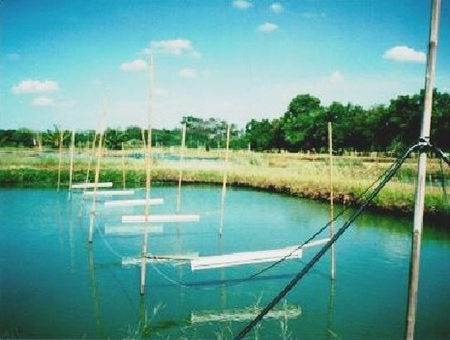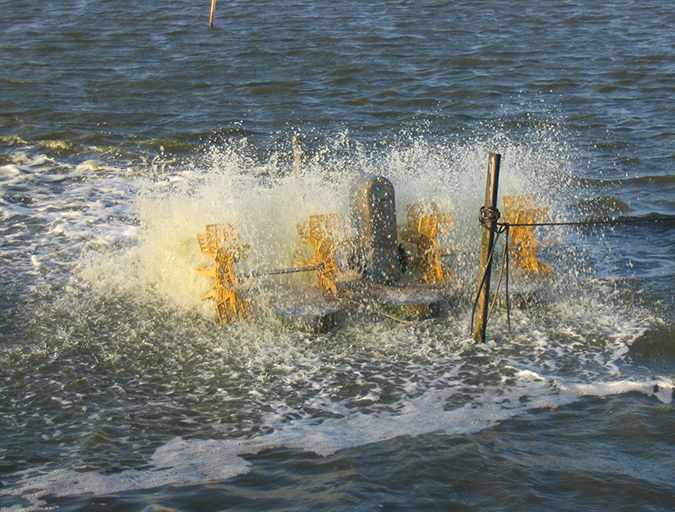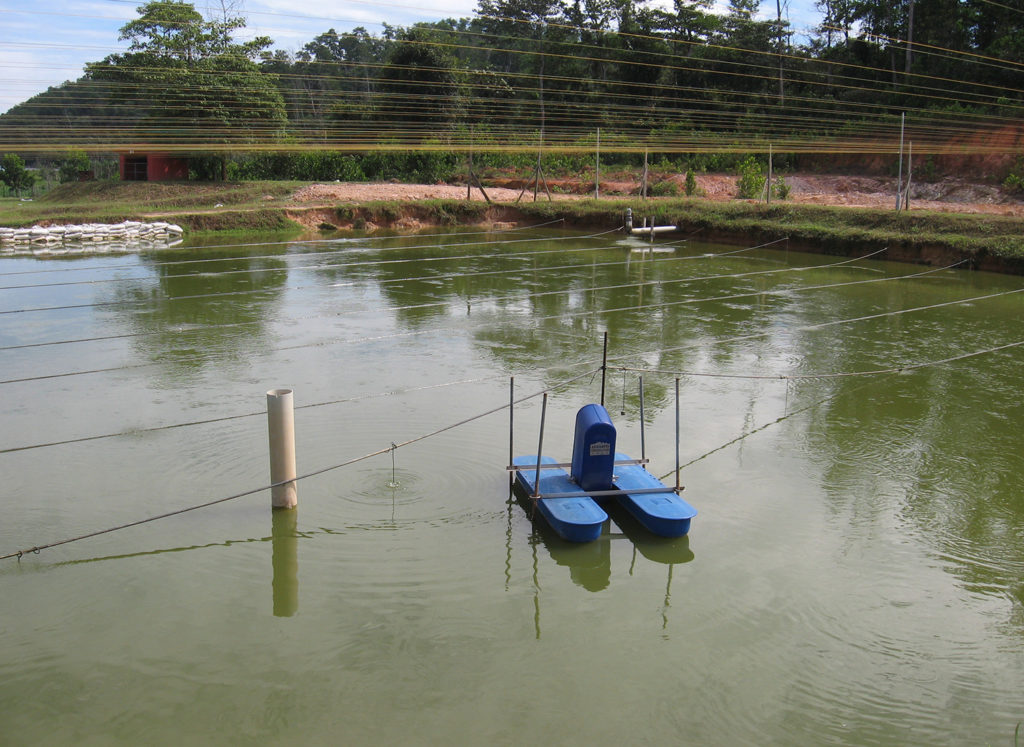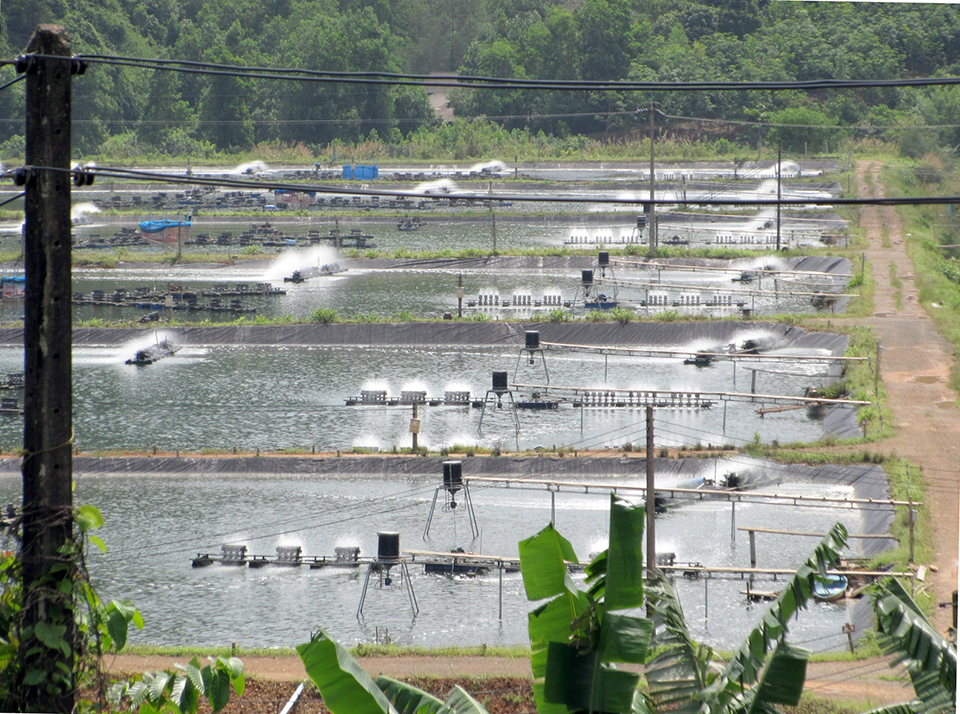Fish in ponds with night lighting had higher growth rates

Light has a growth-promoting effect in temperate fish species, especially salmonids. Fish under lights during the night exhibit increased foraging. As a result, their food intake increases and may enhance growth and production. In addition, nighttime lights attract insects, which can be a source of additional animal protein for the cultured fish.
Increased food intake of about 10 to 15 percent due to light has been reported in Norwegian salmon, resulting in 30 to 40 percent higher growth. Similarly, sibling Atlantic parr grew larger under constant light than under a natural or simulated natural photoperiod.
Although nighttime lighting has not been extensively studied with tropical fish like tilapia, a recent field trial at the Asian Institute of Technology (AIT) near Bangkok, Thailand investigated the effects of nighttime illumination on the growth and yield of Nile tilapia.
Study setup
In the 90-day trial, hormonally sex-reversed, all-male Nile tilapia (Oreochromis niloticus) fingerlings of 10 to 20 grams were grown in eight 200-square-meter earthen ponds. The ponds were fertilized weekly with urea (46 percent N) and triple super phosphate (45 percent P2O5) at 3 kg nitrogen and 1.5 kg phosphorous per hectare per day. All ponds were stocked at three animals per square meter.
Feeding
Fish stocked in four ponds were fed commercial pellets with 30 percent crude protein at 9 a.m. and 4 p.m. daily. Feed was applied at 3.5 percent of estimated biomass during the first 15 days, then at rates decreasing by 0.5 percent every 15 days until reaching 1.5 percent of the biomass. Fish in the other four ponds fed exclusively on natural productivity.
Lighting
Five 40-watt fluorescent tubes were installed in parallel over each of two ponds receiving commercial feed and two ponds without added feed. Placed across the long pond axes at a distance of 3 meters, the lights were on during the night throughout the trial period.
Water quality
An automated data logger connected to a dissolved oxygen (DO) meter measured diel dissolved oxygen and temperature at 5-, 25-, 45- and 65-cm depths. Measurements were simultaneously recorded at two-hour intervals for three consecutive days from the illuminated and nonilluminated ponds. Column water samples were collected from three designated points of each pond, and chlorophyll-α, phaeophytin-α, total ammonia-nitrogen, and nitrite- and nitrate-nitrogen were determined biweekly.
Results
Table 1 summarizes the results of the study. The fish in ponds with nighttime lighting had higher growth rates and production than fish in the control ponds. Similarly, the fish in ponds fed the commercial ration had higher growth rates than fish in the fertilized-only ponds. In the ponds that received only inorganic fertilization, nighttime illumination had little apparent effect on fish growth and production.
Bhujel, Performance of Nile tilapia cultured under semi-intensive conditions, Table 1
| Pond Treatment | Extrapolated Yield (mt/ha/year) | Weight Gain (g/fish/day) | Survival Rate (%) | Apparent FCR |
|---|---|---|---|---|
| No supplementary feeding | ||||
| Control | 9.4a ± 1.2 | 1.0ab ± 0.2 | 91a ± 1.7 | – |
| With nighttime lighting | 11.8ab ± 0.9 | 1.2a ± 0.1 | 89a ± 4.0 | – |
| With supplementary feeding | ||||
| Control | 17.6b ± 0.3 | 1.9bc ± 0.1 | 87a ± 3.1 | 0.9a ± 0.0 |
| Without nighttime lighting | 22.0c ± 0.2 | 2.1c ± 0.1 | 94a ± 2.2 | 0.7b ± 0.0 |
In the ponds that received commercial feed, there was a 25 percent higher (P < 0.05) fish yield from the nighttime illuminated group compared to the nonilluminated group. Feed-conversion ratios were also lower for nighttime-illuminated fish than nonilluminated fish.
No significant impacts on diel temperature and dissolved oxygen regimes were found. Chlorophyll-α concentration and phytoplankton biomass were not affected by the nighttime illumination.
Water quality data showed no significant improvement in culture conditions in the different ponds, indicating that nighttime illumination likely has positive effects on the production of fish growth hormone and/or the efficiency of feed intake and utilization. The lower apparent and true feed-conversion ratios found in nighttime-illuminated fish that received supplementary feeding demonstrated the potential of this alternative. However, it was not clear that light had any impact on growth hormones, as hormone levels in fish were not assessed.
Conclusion
Results of the trial in Thailand indicated it is possible to increase tilapia yields by using nighttime lighting if the fish receive supplementary feed. However, the costs and practical issues associated with lighting must be considered before implementation on a commercial scale. Further research should investigate the effects of different light colors, intensities, and duration on the growth and reproductive performance of tilapia.
(Editor’s Note: This article was originally published in the December 2002 print edition of the Global Aquaculture Advocate.)
Now that you've reached the end of the article ...
… please consider supporting GSA’s mission to advance responsible seafood practices through education, advocacy and third-party assurances. The Advocate aims to document the evolution of responsible seafood practices and share the expansive knowledge of our vast network of contributors.
By becoming a Global Seafood Alliance member, you’re ensuring that all of the pre-competitive work we do through member benefits, resources and events can continue. Individual membership costs just $50 a year.
Not a GSA member? Join us.
Author
-
Ram C. Bhujel, Ph.D.
Aquaculture and Aquatic Resources Management
School of Environment, Resources, and Development
Asian Institute of Technology
P.O. Box 4, Klong Luang
Pathumthani 12120, Thailand[104,116,46,99,97,46,116,105,97,64,108,101,106,117,104,98]
Tagged With
Related Posts

Responsibility
Does Coriolis force impact aerator placement in aquaculture ponds?
The Coriolis effect has no bearing on aerator placement and aquaculture pond management. The most important consideration with mechanical aeration is to provide a sufficient amount to maintain adequate dissolved oxygen concentration.

Health & Welfare
10 paths to low productivity and profitability with tilapia in sub-Saharan Africa
Tilapia culture in sub-Saharan Africa suffers from low productivity and profitability. A comprehensive management approach is needed to address the root causes.

Health & Welfare
Advice for managing predatory birds, part 1
Predatory birds can cause major losses for tilapia farms. As some bird species are protected by law, fish farmers must use non-lethal control techniques.

Aquafeeds
Automatic feeding in shrimp aquaculture
Controlled by timers, automatic feeders should be placed in deeper areas of ponds and away from aerators. Overfeeding is rare during automatic feeding, and pond bottom quality is maintained through grow-out cycles.


